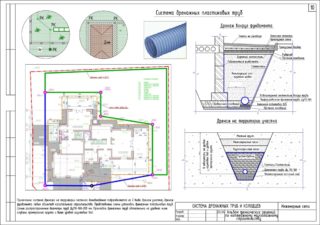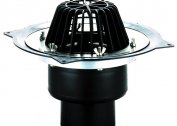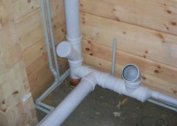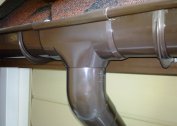One of the important types of land work during the construction of a cottage / summer house is the installation of a drainage system on the site. It helps to drain the soil or to properly remove excess moisture from the building.
Definition and purpose
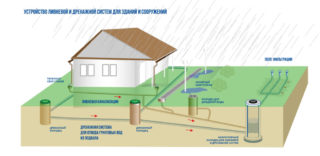 By a drainage system is meant a structure by means of which storm drains or groundwater are removed from the site. Communication is an extensive network covering the entire perimeter of the allotment. All pipes are interconnected. Main drainage purposes:
By a drainage system is meant a structure by means of which storm drains or groundwater are removed from the site. Communication is an extensive network covering the entire perimeter of the allotment. All pipes are interconnected. Main drainage purposes:
- adjustment of the water balance of the soil with an excess or high level of groundwater;
- removal of moisture from buildings and structures subject to a large average annual rainfall in the region.
Indicators for the last item can be obtained from the local meteorological service.
Types and arrangement of drainage systems on the site
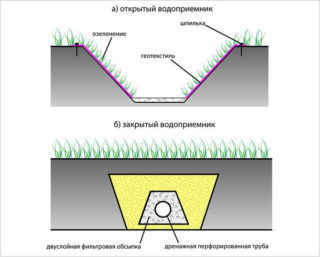 When a drainage system is installed, the drainage system is based on the amount of groundwater in the area, the type of soil, topography and amount of rainfall. Depending on these parameters, choose one of the types of communication:
When a drainage system is installed, the drainage system is based on the amount of groundwater in the area, the type of soil, topography and amount of rainfall. Depending on these parameters, choose one of the types of communication:
- Open, it is surface drainage. Communication is preferable with a normal level of soil moisture (groundwater flows no higher than 2.5 m) and subject to a large amount of rainfall. Open drainage is arranged in a point and linear way. The system is laid no deeper than 50 cm from the surface of the earth. More often it is a gutter with gratings or just channels prepared in the ground with gravel strewn to the bottom, gravel, and broken brick. The last option is good for garden plots.
- Depth drainage (underground). In this case, the system serves to discharge groundwater located high (at the level of 1.5 meters and above). Pipes are laid in prepared channels, wrapped with geotextile, sprinkled with rubble and buried. All drains are interconnected and have a bias towards the discharge point or septic tank / reservoir. To control the efficiency and operability of communication, inspection wells are installed in places of bends and turns of the system.
Excess moisture is discharged to nearby ravines, to aeration fields, to the central sewer line. In this case, all water should be transported by gravity. If the relief of the site does not allow the effluent to be dispensed with pressure, a pump connection is necessary.
Drainage design and necessary calculations
When installing a drainage system around the house and its foundation, all communication should be designed first. To do this, consider the following parameters:
- groundwater level;
- type of soil on the site (sandy, sandy loam, clay, etc.);
- depth of installation of channels / drains;
- length and diameter of laid pipes;
- level of slope towards the point of discharge of effluents;
- distance between stacked drains / trays.
The diagram must indicate all parameters and locations of drains (their beginning and end).
Experts recommend making a distance between channels from 20 to 22 meters if the soil on the site is loose. If the soil is clay, the drains are laid at a distance of 10-11 meters.
For the deep system, the channels are laid at the level of 0.7-1.5 meters. In this case, drains should be located 30-40 cm below the groundwater level. According to SNiP, the slope of the system is observed at a rate of 1-2 cm per each running meter. The larger the cross-section of the pipes, the smaller the slope.
Material selection
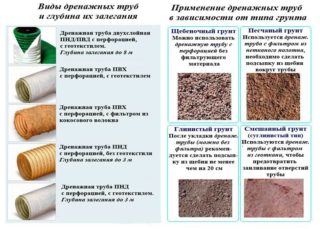 If gutters made of plastic, concrete or asbestos cement with gratings are selected for surface drainage, then special perforated pipes are selected for laying closed communications. They can be made of the following materials:
If gutters made of plastic, concrete or asbestos cement with gratings are selected for surface drainage, then special perforated pipes are selected for laying closed communications. They can be made of the following materials:
- Ceramics. The option is not entirely convenient for private construction, since the material is heavy and expensive. At the same time, the resistance of ceramics to aggressive environments and temperature changes has excellent indicators.
- Asbestos cement. Drains have a smooth inner surface, which increases the flow rate of water in them. However, working with such a material is not very convenient due to its high weight.
- Stainless steel. Heavy but corrosion resistant material. Serves up to 15 years.
- Polymers: PVC, polypropylene or HDPE. Ideal options are drains made of low or high pressure polyethylene. They are resistant to low temperatures, ductile, durable, have a smooth inner surface. At the same time, the weight of the material allows you to work with it even alone.
For installation of deep drainage communication, it is worth taking pipes of brown or green color. They are designed for outdoor use.
In addition to drains, you need to prepare the following materials:
- Wells: viewing, overflow, overflow, accumulative. They can be made from ready-made corrugated pipes, which is very convenient, but you can independently mount them from masonry, reinforced concrete rings, and even car tires. The latter option is laborious and not always durable.
- Rubble. It serves as the primary drainage layer to prevent fine sand and debris from entering the pipes. However, do not take calcareous material. It collapses under the influence of water and leads to salinization of the soil. It is better to take granite or dolomite. It is desirable that the fraction of crushed stone was in the range of 2-4 mm.
- Broken brick. It is necessary when installing an open surface drainage system.
- Geotextile. An important element that prevents clogging of the system. It is woven and non-woven. The first option is ideal for the installation of a deep drainage system. The second option is multifunctional, but it is not necessary. Yes, and it costs more.
To equip storm sewers, take geo-style with a density in the range of 100-200 g / m2.
Installation Steps
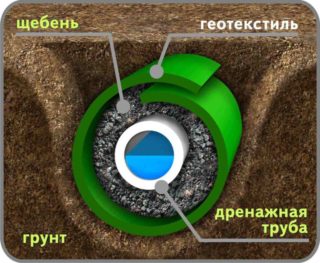 The process of the drainage device is divided into stages:
The process of the drainage device is divided into stages:
- At a given depth, ditches are laid for laying pipes or trays. The soil in them is carefully compacted.
- At the bottom of the trenches, a layer of sand 7 cm thick is poured and it is well rammed.
- The next layer of the drainage roll is crushed stone of a small fraction. Its layer is 10 cm-15 cm.
- Mount geotextiles so that its free edges protrude 20 cm at both ends.
- Pipes are laid on the fabric and wrapped in filter material.
- A layer of rubble is again poured on top.
Ready communication is covered with soil. But it is forbidden to ramp the earth. Over time, she will sit down herself.
Common Drain Installation Errors
When installing drainage on a site, novice masters often make ridiculous mistakes:
- Lack of geotextile on drains in clay soil. In this case, the pipe will eventually become clogged with sand. A blockage will occur in the sewer that will need to be removed by flushing or cleaning the line.
- Lack of bias towards the receiver. As a result of such a construction blooper, the water will, on the contrary, stagnate on the site, instead of flowing freely into its lower part.
- Insufficient drainage depth. If this parameter is neglected, all efforts to arrange communication will be in vain. Water simply will not completely leave the site.
The elimination of such errors allows you to mount effective communication.
Operation and maintenance of the drainage system
The finished drainage line on the site requires maintenance and compliance with the principles of its operation. Regularly carry out such activities:
- Once a season (spring and autumn), the drainage through the inspection wells is checked. If you notice that water stagnation has formed in one of the arms, you need to clean this area.
- Once every 4-6 years, a thorough cleaning or flushing of the pipes is carried out. To do this, use special installations with accessories for them (nozzles, brushes, etc.).
It is advisable to lay pipes whose diameter allows filling the system by 30%. In this case, even when the line freezes, it will not break from temperature extremes.
